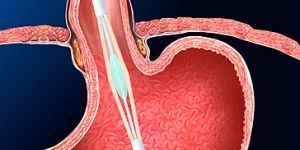Article
Mechanism of Radiofrequency Treatment of GERD Patients Explored
Author(s):
Radiofrequency treatment of patients with refractory gastroesophageal reflux disease appears to improve symptoms by decreasing compliance of the gastroesophageal junction, a new study suggests.

Radiofrequency treatment of patients with refractory gastroesophageal reflux disease (GERD) appears to improve symptoms by decreasing compliance of the gastroesophageal junction (GEJ), a new study suggests. The study, carried out by researchers at the University of Leuven in Belgium, was published online late last month in the American Journal of Gastroenterology.
The researchers conducted a double-blind randomized cross-over study including 22 GERD patients, with 11 receiving Stretta radiofrequency treatment and 11 receiving sham treatment. Assessment of symptoms, endoscopy, manometry, 24-hour esophageal pH monitoring, and a distensibility test of the GEJ were all performed before and after a three-month treatment period.
For patients who received the Stretta procedure, no changes were observed in esophageal acid exposure or lower esophageal sphincter pressure, while symptom score was significantly improved and GEJ compliance was significantly decreased. The researchers conclude that the latter change may contribute to symptomatic benefit by decreasing refluxate volume.
"In this double-blind, sham-controlled study, our data confirms that Stretta improves the physiology of the lower esophageal sphincter, and that this is the likely mechanism for symptom improvement in GERD," said Jan Tack, MD, PhD, one of the study's authors and head of clinic in the department of gastroenterology in the Center for Gastroenterological Research at the University of Leuven, in a press release. "In addition to the noted effectiveness of the Stretta treatment, we believe that the method we employed in the study was able to exclude fibrosis as the underlying cause of the observed significant decrease in GEJ compliance."





